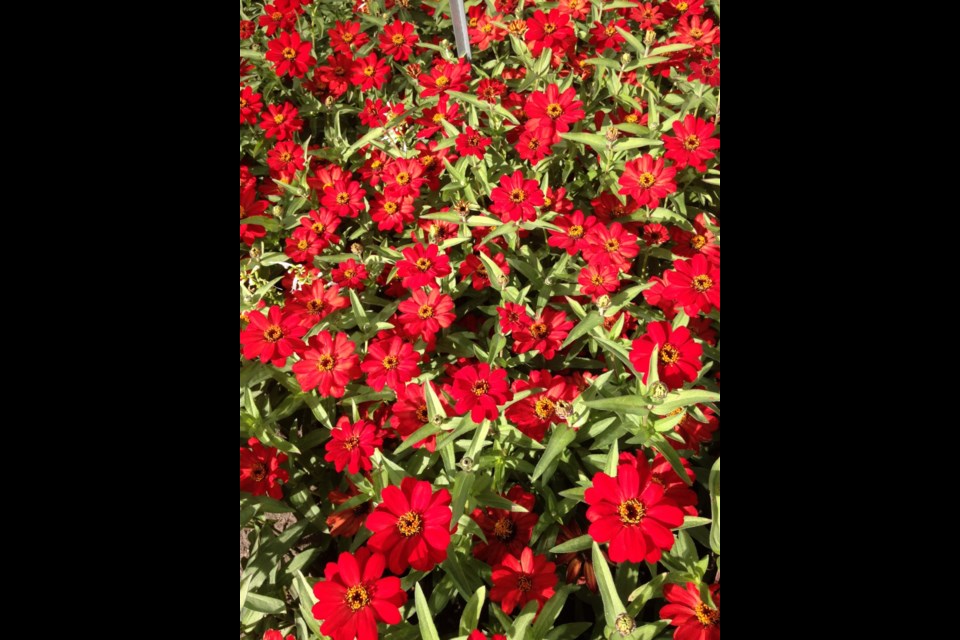The brilliant colours of a well-designed annual flower bed can be awe-inspiring. Once those flowers start to bloom in early summer, the show usually carries right through to a killing frost in fall. Many annual flowers perform well in the Prairie garden but one of my favourites is zinnias.
Zinnias (Zinnia elegans and Zinnia augustifolia) are part of the Asteraceae family of plants (also known as the daisy or sunflower family). One of the most obvious characteristics of this plant family is the composite flower heads. Composite flower heads appear as one flower however, they are composed of many small flowers called disc flowers that may or may not also have ray florets. These ray florets occur as colourful petals.
Zinnia flower heads have disc flowers in the centre of the head that are usually surrounded by colourful ray florets along the circumference. Some zinnia inflorescences are rather simple with tight, button-like colourful center of disc flowers surrounded by a single row of ray florets (like a daisy) or they can be made up of several rows of ray florets surrounding a small area of disc flowers (like a dahlia flower). The inflorescences can also vary in size from small pom poms to large 10-15cm diameter flowers. Some zinnias can have speckled or streaked petals and some inflorescences are multi-colored.
Originating in the southwestern part of Mexico near Tixtla, Guerroro, zinnias naturally prefer warm, sunny locations. Although they can withstand some drought, zinnias should be watered regularly. Zinnias that suffer extended periods of drought will not recover well. Alternatively, zinnias that are grown in shady, cool conditions will be prone to be infected by powdery mildew and botrytis if overwatered or grown in shady, cool conditions. If you notice the bottom leaves on your zinnias starting to wilt and die back, remove these infected plants immediately as the botrytis will quickly spread to neighbouring zinnia plants.
Zinnias can be transplanted or direct seeded in the garden in early spring. Seed germinates easily and plants grow quickly. In nature, zinnias are typically 15cm in height however through many years of breeding and hybridization, hundreds of different zinnias are available that range in size from 10cm to 1m tall. Flower colours can be found in purples, reds, pinks, oranges, yellows, creams, white and every shade in between. ‘Queeny Lime Orange’, a 2018 All American Selection winner, starts as a lime green colour and matures to light orange colour later in the season.
Zinnias are one of the best flowers for attracting pollinators and butterflies. Interplant your vegetable garden with a row of zinnias for better fruit production in your cucumber, melon and squash patch. Generally, the taller cultivars with flat-topped flowers are more adapted to pollinators and butterflies than the dwarf cultivars. The yellow-centred flowers with the disc floret provide more nectar than the double-flowering blooms.
Zinnias bloom throughout the season. Deadheading (removing spent flowers) not only encourages more flowers but also promotes branching of the plants. Fertilizing the plants with a 20-20-20 soluble fertilizer once/a month will stimulate and support healthier plants and ample blooms. If transplanting zinnias in spring, water in the transplants with a 10-52-10 soluble fertilizer. Always mix any fertilizer according to label directions.
There are many different types of zinnias available. The Profusion series of zinnias are mounding plants, approximately 45cm tall and up to 60cm wide, with ‘profuse’, 5cm diameter blooms. Many colours are available.
Double Zahara™ series of zinnias are compact plants with excellent disease resistance and are recommended for containers and flower beds. The fully double flowers are 2-5cm. Deadheading flowers is not necessary in the Zahara™ series.
Two zinnias recommended as cut flowers are the Benary and Oklahoma series of zinnias. Benary’s zinnia series produces giant flowers (10-15cm across) in bold colours. The Association of Specialty Cut Flowers recommends the Benary series for its vigour, uniformity and productivity throughout the season.
The Oklahoma zinnia series produces medium-sized semi-double blooms and displays good powdery mildew disease resistance. Deadheading is recommended for these cut flower series to increase branching and blooms.
Cactus flowered zinnias are eye-catching and unique. These large blossoms (15-30cm) grow on stalks up to 1.2m tall. The ray florets are multi-layered and ‘quilled’ (ie. individually rolled in a tubular shape). Recommended for cut flowers, the plants will produce several cuttings as a ‘come and cut again’ flower.
If you’re looking for an easy annual flower with a lot of color throughout the season, zinnias are the way to go. You could grow a new one every year and not get through all the colours and series in one lifetime. My favorite is ‘Zowie!™ Yellow Flame’ but there are hundreds from which to choose.
This column is provided courtesy of the Saskatchewan Perennial Society (SPS; [email protected] ). Check our website (www.saskperennial.ca) or Facebook page (www.facebook.com/saskperennial) for a list of upcoming gardening events




